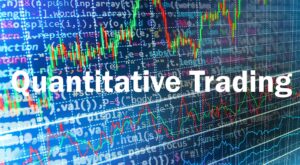Quantitative trading is a type of marketing strategy in which mathematical and statistical models are used to identify and execute opportunities.
This marketing strategy is also referred to as “quant trading” in which models are driven by quantitative analysis and from here the name of the strategy gets the name as quantitative trading.
In this method, proper research and measurement are required to identify the complex pattern of behavior into numerical values.
To apply this strategy one needs a lot of computational power so it is used by only a large institutional investor in old times. But nowadays many individual traders are also started getting involved in it due to the availability of the latest technology.

Quantitative trading- how it works?
The method used the data-based models by which one can identify the probability of a certain outcome. It totally relies on the statistical method and programming to determine the specific output.
For instance, if you find a spot volume spike for X company stock which is quickly followed by price value then you need to build a program that analyzes this pattern across the entire market history of that X company.
By analyzing this if you find the pattern which has resulted in a move upwards of 96% in the past then you can predict a similar pattern will occur in the future.
In this model, the data of price and volume is examined by quant traders. But if any parameter found which distilled into a numerical value can be considered into this strategy.
Moreover, quant traders analyze lots of data-base which are publicly available to build their statistical model. With the help of this database, one can determine the outside patterns of traditional financial sources, like fundamentals.
Difference between quantitative vs algorithmic trading
As far as algorithmic trading concern then algo traders used an automated system to analyze the chart pattern and then open and close the position on their behalf.
While in a quantitative trading statistical method is used to identify but it is not necessary that they will execute it.
Quantitative trading systems
This system contains 4 components that help quant traders to identify new opportunities.
- Strategy
- Back-testing
- Execution
- Risk management
Let’s see these components one by one:
1. Strategy
In this step, traders will analyze the strategy to decide which one they should follow.
Once they decided, the next task will be a mathematical model and then they will refine it to lower the risk and increase the profit.
2. Back-testing
In this component historical data is applied as it helps to know how it performs well in a live market.
It is one of the essential parts of the automated trading system but there is no guarantee of profit when a model is live.
3. Execution
Either it is an automated or manual one, each system contains an execution component.
Generally, API is used in an automated system to open and close the position as quickly as possible without human input.
The key aspect of this execution is to minimize the transaction cost which includes commission, tax, slippage, and spread.
4. Risk management
If you are involved in trading then it is necessary to include risk management in your trading strategy.
It refers to anything which can interface along with the success of a strategy.
Capital allocation plays a crucial role in the area of risk management. It is important to keep an eye on how much capital goes into each model if multiple systems are used.
If we keep a strategy left alone on its creator then the chances are increased that it will immune the human bias.
What is a quant trader and what do they do?
It is interesting to know those quant traders are totally different from traditional investors. The approach they follow is totally different compared to the traditional one.
Quant traders are generally mathematicians instead of being financial experts of the market.
If any quant firm wants to hire then they will prefer the people who have a thorough degree in math, engineering, or financial modeling along with experience in data mining and the making of an automated system.
If you want to enter in the field of quant trading then make sure that you are pro efficient in this area along with mathematical concepts like conditional probability and value at risk (VAR).
Instead of building their own strategies, quant traders often customize the existing one and make it successful.
To accomplish this task quant trader builds a program to do it rather than doing it manually. This will need programming expertise and the ability to work with data feed and API.
What are the pros and cons of quantitative trading?
The biggest benefit of quantitative trading is that it enables you to study the market potential at a huge level along with limitless data points. In addition to this, RSI signal as uses as RSI trading strategy in quantitative trading.
While traditional traders will consider only look at a few factors only while evaluating the market.
They always stab to the areas in which they are experts while quant traders use mathematical modeling to break this constraint.
This method helps alleviate some of the human emotions which affect trading. Instead of focusing on emotion, the method will totally rely on the stats and database decision.
However, this method has also its own limitation. The model and the system generated with this method help only to those who create them.
The market of finance is completely unpredictable and dynamic as sometimes you get profit and sometimes loss.
Due to this reason, quant trader requires expertise in mathematical experience, coding efficiency which is not possible for everyone.
